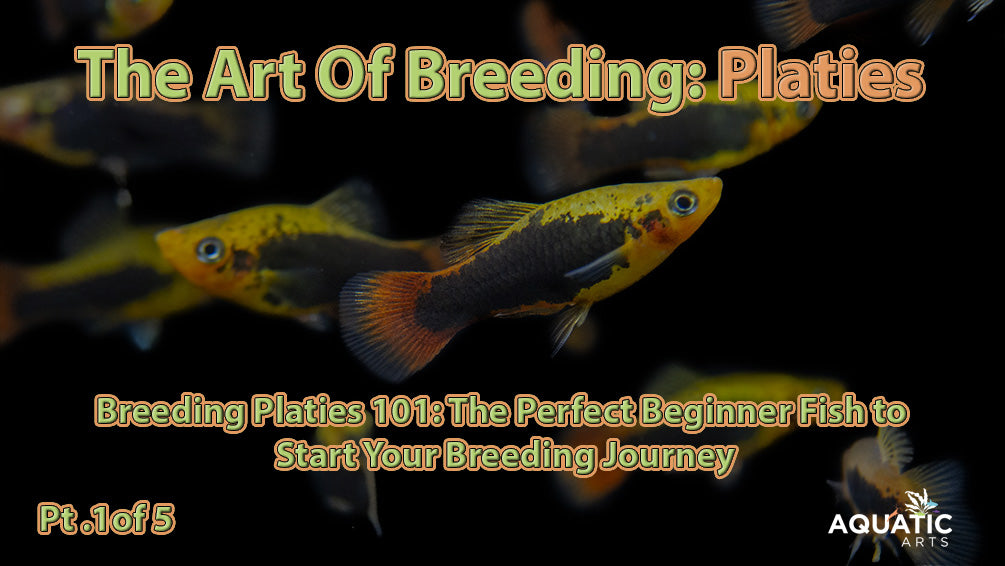Why Platies Are a Beginner Breeder’s Dream Fish

Breeding Platies 101: The Perfect Beginner Fish to Start Your Breeding Journey
Colorful Variety and Simple Care Needs
One of the first things that draws aquarists to Platies is their eye-catching colors. From fiery reds and electric blues to golden yellows, Platies bring vibrant energy to any tank. Unlike more delicate fish, Platies are remarkably resilient and adapt well to various tank conditions, making them easy for beginners to care for. Platies are also peaceful and easy to pair with other community fish, making them ideal for community tanks.
Livebearers: A Natural Breeding Process
If you’re interested in seeing fry firsthand, Platies are a perfect choice! Unlike egg layers, Platies are livebearers, so females give birth to fully formed, free-swimming fry. This takes out the need for egg incubation or special care, making it a simple, enjoyable experience for beginner breeders.
Trio Packs for Easy Setup
Starting with a Trio—one male and two females—creates the perfect environment for breeding without adding too much pressure to a single female. This ratio allows both females to have “downtime” from the male’s attention, encouraging a healthier and more natural breeding process. Our Platy Trio Packs are designed with this balance in mind to make breeding easy and successful from the start!
Ready to set up your Tank to start breeding? Check out the second Blog in this series called: Platy Breeding Tank Setup Made Simple: Essentials for Success
Q&A: Common Questions About Platy Breeding
Q: What makes Platies good for beginner fish breeders?
A: Platies are hardy, peaceful, and low-maintenance, making them easy to care for and breed.
Q: How quickly do Platies breed?
A: Platies can breed roughly every 4–6 weeks, with each pregnancy lasting around 28 days.
Q: How many fry do Platies have?
A: A female Platy can give birth to 20–50 fry in one brood, although this can vary.
Q: Do I need a separate breeding tank?
A: Not necessarily, but adding plants and decorations for hiding spots helps protect fry in community tanks.
Q: How do I know when my Platy is pregnant?
A: Look for a rounded belly and a dark “gravid spot” near the rear fin—signs she’s carrying fry!
Q: What colors do Platies come in?
A: Platies come in reds, yellows, blues, oranges, and mixes of these colors—each adding unique beauty to your tank.
Q: How can I protect Platy fry from adult fish?
A: Provide plenty of hiding spots with plants and décor, and consider a breeder box if necessary.
Q: What should I feed Platy fry?
A: Special fry food, crushed flakes, and live foods like baby brine shrimp work well for growing fry.
Q: Are Platies compatible with other fish?
A: Yes, they’re generally peaceful and do well with other community fish like tetras and guppies.
Q: How often should I clean a Platy tank?
A: Weekly water changes of about 20% help maintain water quality without stressing the fish.
Starting a breeding project with Platies is both rewarding and simple, making them the perfect choice for beginners. In the next post, we’ll guide you through setting up the ideal breeding tank, from the best tank size to creating hiding spots and maintaining water quality. Get ready to give your Platies a great environment for breeding success!
Check out the full series in order below:
Blog 1: Why Platies Are a Beginner Breeder’s Dream Fish
Blog 2: Platy Breeding Tank Setup Made Simple: Essentials for Success
Blog 3: How to Care for Pregnant Platies and Get Your Tank Fry-Ready
Blog 4: Raising Platy Fry and Creating a Thriving Breeding Program
Blog 5: How to Feed, Care For, and Grow Your Platy Fry




